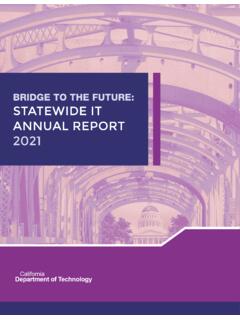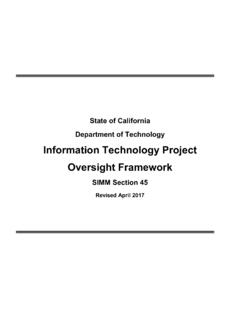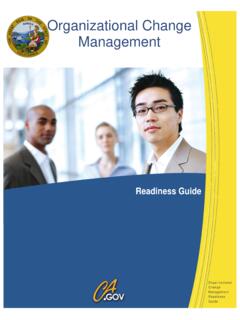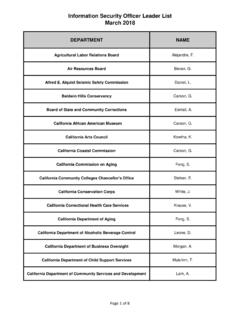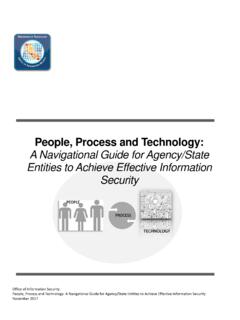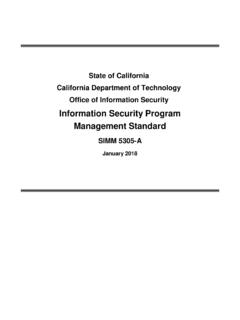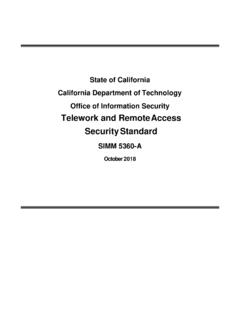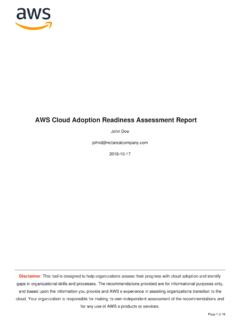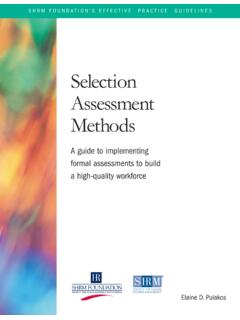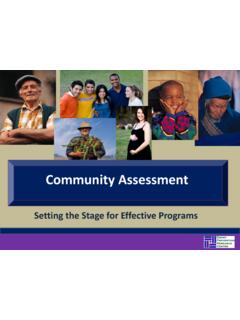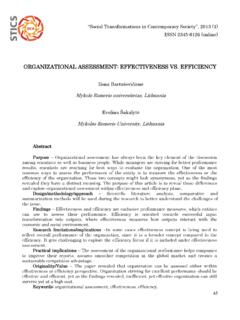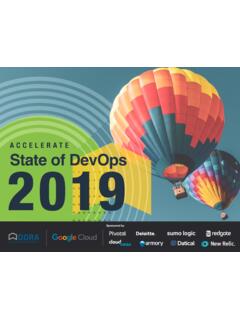Transcription of Organizational Change Management Slide Deck
1 The Project Academy Series: Understanding and Implementing Organizational Change Management September 18th and 19th, 2014. Welcome and Introductions Jacquelyn Moore: IT Project Manager, Project Delivery, Caltrans Jessica Chin: Section Manager, SAP Enterprise Systems Functional and Business Analysis, DWR. 2. Agenda Objectives What is Organizational Change Management (OCM)? The Human Factor at Organizational Level Where do you start? Fundamentals, Tools, and Templates Wrap-Up Questions 3. Objectives What Is OCM? Why It Is Important The Human Factor Organizational Goals and Objectives Recognize the 5 Pillars of Successful Change Utilize OCM Tools and Templates 4. Cross Your Arms 5. Organizational Change Management What is it? Why is it important?
2 Five Pillars of Successful Change 6. Organizational Change Management Organizational Change Management is an approach to transitioning an organization including its people from their current state to a new state. People Process Ready Culture for Strategy Change 7. Organizational Change Management Why is it important? Organization can drive better performance and amp up business results through effective Change Management . Leading Change is an important part of a leader's job. Top 5 Organizational Change Challenges: 1. Resistance from the people who need to Change 2. Navigating the political landscape 3. Addressing team dysfunctions 4. Difficult conversation/coaching/feedback to senior leaders 5. Dealing with ambiguity, uncertainty, inability to forecast the future 8.
3 5 Pillars of Successful Change Communication Sponsorship Stakeholder Management Readiness Training and Turnover 9. How Does OCM Fit Into Your Business Goals and Objectives? Bringing Strategy to Life . 10. Cultural Alignment: Making It Real What defines an organization's culture? Culture generally refers to the shared set of values, principles, assumptions, beliefs, symbols and behaviors that reflects how work gets designed and executed. In short, it's how things are done around here. Of course, no two organizations' cultures are exactly alike. 11. What makes up a organization's cultural profile? In other words what makes an organization successful? Efficiency, Quality, Innovation, Customer Service, Company Image 12. 13. Human Side of Change People By creating Awareness you define the problem and create a common understanding.
4 Understanding creates the Desire to fix the problem, establishing ownership. Ownership drives the Knowledge to find a solution. Owning solutions leads to Acceptance of Change . Acceptance leads to SUCCESS! Success with the PEOPLE who influenced the Change ! REINFORCE through awareness and training, even after your project has ended. 14. OCM at Organizational Level 15. Where Do You Start? 16. Stages of Change 17. Project Work Plan (OCM WBS). Templates\Sample OCM Project Schedule 2007 18. Strategy: Aligning OCM Lifecycle with Project Lifecycle 1. Preparing 2. Managing Planning 3. Managing Execution 4. Transition 5. Monitoring 19. Change Readiness Assessment Why is it important? What does it tell you? Best Practices 20. Why Is It Important?
5 Culture and value system Capacity for Change Middle Management 's predisposition toward the Change Employee readiness for Change 21. Change Readiness Assessment 22. Exercise 10 Minutes 23. Instructions Think of a Change initiative your organization needs to implement. Take the assessment individually based on your role in your organization. There are 5 short questions for each of the five Pillars. Enter a response that best represents your organization's ability to manage Change . 24. Things to think about when filling out the assessment well does your organization function during Change efforts? well positioned is the organization to be able to absorb all the changes planned without creating significant risk of overload in affected areas?
6 Are the resources involved and what is their degree of skills and experience? is your leadership's capability of sponsoring and supporting Change ? generates desire for the Change and what creates resistance to it? do you need to improve support and reduce roadblocks for the Change ? is your corporate culture and historical experience in dealing with Change ? 25. What does it tell you? Average score is calculated at each Pillar Risks and potential obstacles Gaps in communication, training, sponsorship, and transition strategy required to implement Change Special Tactics needed to support and sustain Change 26. What do you do with the results? If your average score is below 4 for any of the categories, this indicates the organization is not fully prepared and should spend efforts on that pillar to improve readiness.
7 Develop strategies to address areas that need improvement. Select a Change Management team model and team size. Select a sponsorship model and support system. Customize communication plans, training plans, coaching plans and sponsorship activities. 27. Best Practices Change Management team or project leaders use the assessment as a tool to assess the organization's readiness to Change . Independent vs. Third Party Agile, flexible Unbiased opinion Include employee and manager interviews and surveys. When collecting data from a large number of employees, focus groups can also be used in place of one-on-one interviews. 28. Best Practices (Continue). Use it to plan your Change Management strategy and help the project team make informed decisions to managing Change .
8 Use it as a planning aid and not as the bulk of the Change Management effort. 29. Break 15 Minutes 30. OCM Fundamentals, Tools, and Templates OCM Methodologies OCM Strategies Five Pillars of Change 31. Common Methodologies PROSCI/ADKAR. 32. Organizational Change Management 33. Five Pillars for Successful Change 1. Communication 2. Sponsorship 3. Stakeholder Management 4. Readiness 5. Training 34. Communication Communications Strategy and Plan Establish audience groups Tailor your messaging Use multiple delivery channels Be visible Templates\ 35. Executive Sponsorship Sponsors build commitment Have Competing priorities Decision makers Sponsor Meetings Establish Directives / Policies Champions the effort Templates\OCM- Change -Leadership- 36.
9 Stakeholder Management Conduct Stakeholder Impact Analysis Actively engage your partners and commit to a partnership. Understand the reason, need and benefits of Change . Address the concerns Templates\OCM Stakeholder 37. Readiness Assess your organization's readiness before implementation People, Culture, Processes, Strategic Alignment Establish a Change Team Celebrate success and early wins 38. Training and Transition Establish a comprehensive training plan Train your leaders and Change agents in OCM. Training Needs Assessment Identify roles and skill building requirements Transition Plan Reinforce and encourage learning 39. Wrap-Up Be ahead of Change , OCM starts at the BEGINNING. Assess your organization's readiness for Change Incorporate the Five Pillars of Successful Change Understand the human factor of Change the people 40.
10 The Readiness Guides Project Readiness Guides 41. Questions 42.
